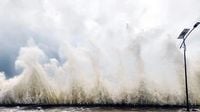As the sun rose over the eastern seaboard of the Philippines on September 24, 2025, meteorological agencies across Vietnam and neighboring countries were on high alert. A tropical storm, internationally named Bualoi, had begun to stir unease across the region, prompting urgent responses from authorities and communities alike. According to the Meteorological and Hydrological Station of Nghe An province, at exactly 7:00 AM that morning, the storm’s center was pinpointed at approximately 9.8 degrees North latitude and 132.4 degrees East longitude. Winds near the core of the storm were already formidable—classified at level 9, with gusts reaching up to level 11. These numbers may sound abstract, but to those who make their living on the water, they spell real danger.
The National Steering Committee for Disaster Prevention and Control wasted no time. By midday, they had issued Official Document No. 04, urging all coastal localities from Quang Ninh in the north to An Giang in the south to brace for impact. The forecast, echoed by the National Center for Hydro-Meteorological Forecasting and reported by outlets such as Báo Nghệ An and Thanh Hóa Radio and Television, was clear: Bualoi was expected to enter the eastern area of the East Sea (known internationally as the South China Sea) around midnight on September 26, 2025. When it does, it will become the tenth named storm to threaten Vietnam that year—a sobering milestone for a country all too familiar with the annual onslaught of typhoons.
In response to the looming threat, the Provincial Steering Committees for Disaster Prevention in Thanh Hoa and Nghe An issued detailed directives to local authorities and residents. These instructions, as reported by baonghean.vn and dhcn.vn, emphasized a multi-pronged approach: closely monitor all official storm warnings, inform ship captains and vessel owners of the storm’s progress, and urge them to seek safe harbor or adjust their production plans to avoid unnecessary risks. The message was simple but urgent—protect people and property above all else.
“All localities must maintain communication with ships at sea to promptly handle adverse situations,” stated the National Steering Committee for Disaster Prevention, as cited by dhcn.vn. The directive wasn’t just for show. In coastal provinces like Thanh Hoa and Nghe An, where fishing fleets are a lifeline for many families, maintaining radio contact with vessels is a matter of life and death. The authorities also called for rescue forces and equipment to be kept on standby, ready to deploy at a moment’s notice if disaster struck.
From the evening and night of September 26 onward, weather forecasters predicted that the northeastern and central regions of the East Sea would experience rapidly intensifying winds. Initial gusts of level 6-7 were expected to escalate quickly to levels 8-9—a range considered hazardous for most maritime activities. Ship captains were advised not to take any chances. As the Thanh Hoa Meteorological and Hydrological Station put it, “We are closely monitoring and forecasting to promptly warn and implement response measures.”
But the response wasn’t limited to those at sea. Broadcasting agencies in Thanh Hoa and Nghe An ramped up their coverage, ensuring that updates about the storm’s trajectory and intensity reached every corner of the coastal provinces. Local radio, television, and public information systems worked overtime, relaying bulletins not just to officials but directly to the people whose lives and livelihoods hung in the balance. “We are increasing information dissemination to authorities, maritime operators, and residents for proactive prevention and response,” reported Thanh Hoá Radio and Television.
Behind the scenes, duty officers at provincial and national disaster prevention offices worked around the clock. Strict reporting schedules were enforced, with regular updates sent to the National Steering Committee for Disaster Prevention and the Ministry of Agriculture and Rural Development. The aim was to ensure that no development, no matter how minor, went unnoticed or unaddressed. Every department, from meteorology to fisheries, had a role to play. As the official directive from Thanh Hoa’s Provincial Steering Committee stated, “Relevant departments and agencies are managing and coordinating disaster response efforts, maintaining strict duty schedules and reporting regularly to the Disaster Prevention Steering Office.”
For many in Vietnam, this level of preparedness is a hard-earned lesson from past storms. In recent years, typhoons have grown more unpredictable—sometimes stalling offshore, sometimes veering unexpectedly inland. The government’s strategy now hinges not just on reacting to disasters, but on proactive, coordinated planning. That means not only issuing warnings but ensuring that those warnings reach the right people, at the right time, with clear instructions on what to do.
There’s also a human element to this story that often goes overlooked. In fishing villages along the coast, September is typically a busy month, with fleets venturing out to sea before the winter monsoon sets in. For ship captains and crews, the news of Bualoi’s approach is both a financial blow and a personal worry. “We informed ship captains and owners of vessels moored at ports or operating at sea to proactively avoid the storm and have suitable production plans ensuring safety for people and property,” the Nghe An Provincial Steering Committee reported, according to baonghean.vn. It’s a delicate balance—protecting livelihoods without risking lives.
In the coming days, as Bualoi edges closer to the East Sea, all eyes will be on the skies—and on the latest bulletins from meteorological stations and disaster prevention offices. The hope is that, through vigilance and cooperation, the region can weather yet another storm season with minimal loss and disruption. It’s a cycle that repeats every year, but with each new typhoon, the resolve to prepare and protect grows stronger.
As of September 24, the storm’s path and intensity were being monitored by agencies up and down the coast, from Quang Ninh to An Giang. Forces and equipment for rescue and emergency response remained at the ready, while strict duty shifts and regular reporting kept the lines of communication open. It’s a testament to the resilience and adaptability of Vietnam’s disaster response system—a system forged in the crucible of past storms, now facing the future with eyes wide open.
With Bualoi’s arrival imminent, the next forty-eight hours will test the preparedness and coordination of everyone involved, from government officials to fishermen and broadcasters. For now, the message is clear: stay alert, stay safe, and trust in the collective effort to weather whatever comes ashore.




